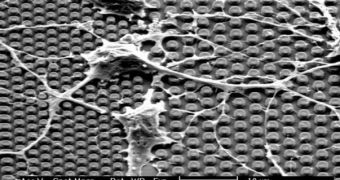Scientists at the Interuniversity Microelectronics Center (IMEC) have recently showcased their latest innovation, a small microchip that is able to mediate communications between electrical and biological cells. The find could be of tremendous use for the field of physiology, as well as for the development of new generations of prosthetic devices for example, where living cells need to be able to transmit messages to robotic devices. According to experts at the Center, the chip is both mass-producible and inexpensive, which leads them to believe that it will be widely accepted, ScienceDaily reports.
The new instrument could also be used for basic research into the way the human brain functions, the group adds. The device contains a large number of fingernail-shaped structures, each of which connects a single biological cell with an electrode that can easily trigger electrical activities in a dedicated electrogenic cell in a larger network. This level of interaction, at the cellular level, could serve a lot of purposes, in many fields of research, IMEC experts believe. Electrogenic cells are a larger group which included brain cells, as in neurons, and cardiomyocytes, or heart cells.
Both these types of cells relay on electric signals to communicate, and understanding these “messages” is absolutely vital to figuring out how the neural pathways, for example, work. This line of research also opens the way towards finally clearing the medical mysteries associated with the development of conditions such as Alzheimer's and Parkinson's. The new mechanism could offer a method of analyzing the impact of heart drugs have on the organ, without the need to unnecessarily expose volunteers to unknown risks, scientists say.
“We tackled several challenges to realize this micronail chip such as keeping the cells alive on the chip surface; combining the wet cell solution with the electronics underneath without destroying the electronics; guiding the cell growth so that the cell body is just on top of one individual electrode; and last but not least: bring the cells as close as possible to the chip surface. Now, we have a unique instrument to record and interpret the signals of the neurons. We can also stimulate neurons and follow up the consequences to unravel the functioning of our brain,” explains IMEC Bioelectronic systems Group manager Wolfgang Eberle.

 14 DAY TRIAL //
14 DAY TRIAL //